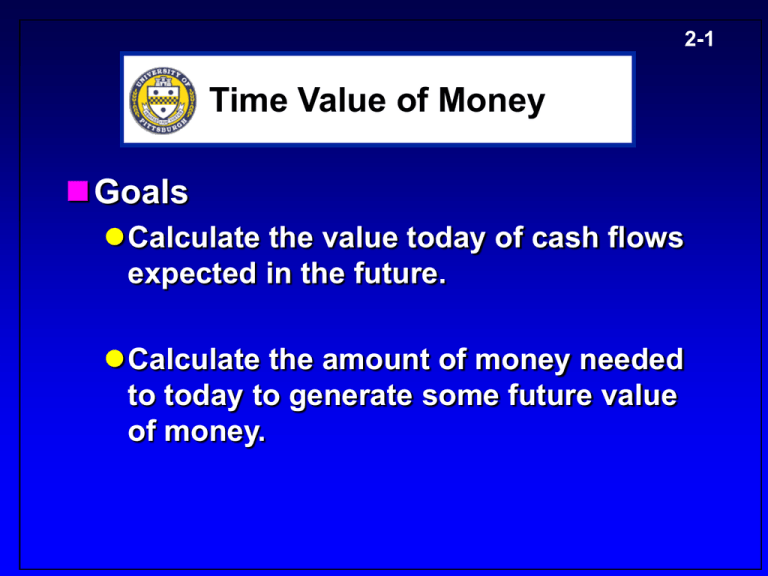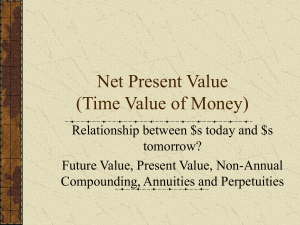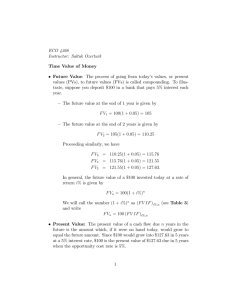What is Finance?
advertisement

2-1 Time Value of Money Goals Calculate the value today of cash flows expected in the future. Calculate the amount of money needed to today to generate some future value of money. 2-2 Time Value of Money Present values versus future values Interest rate conversions Annuities Perpetuities Growing cash flows Amortization (loan) payments Pricing bonds and stock 2-3 Future Values 0 C0 1 FV1 = C0(1+r) 2 FV2 = FV1(1+r) = C0(1 + r)2 FVt = C0 × (1 + r)t How much would $70,000 be worth in 14 years @ 7½%? FV14 = 70,000(1.0725)14 = $186,492 2-4 Present Values 0 PV = PV1/(1 + r) = C2/(1 + r)2 1 PV1 = C2/(1 + r) PV = Ct / (1 + r)t 2 C2 Note that this is the same formula as for FV What is the maximum price you would pay today for a machine that generates a single cash flow of $2,000,000 in 20 years? Interest rate is 8% What if you sell this machine? PV = 2,000,000/(1.08)20 = $429,096 2-5 Multiple Cash Flows 0 C1 C2 CT 1 2 T Ct in year t, cash flows last for T years PV = [C1/(1+r)] + [C2/(1+r)2] +……+ [CT/(1+r)T] T PV = [Ct / (1+r)t] t=1 2-6 Multiple and Infinite Identical Cash Flows 0 C C C C 1 2 T Annuity: Finite stream of identical cash flows Perpetuity: Infinite stream of identical cash flows Identical: separated by an identical growth rate (g=0 in this example) 2-7 Perpetuities and Annuities Perpetuity: C PV r C Annuity: PV of annuity r 1 1 t (1 r ) How about future values? FV of annuity C (1 r ) t 1 r Understand formula using timelines 2-8 Growing Cash Flows Growing Perpetuity 0 C C(1+g) C(1+g)2 C(1+g)3 1 2 3 4 Growing Annuity Growing Perpetuity: C PV rg Growing Annuity: C PV rg PV What about a (growing) perpetuity starting in year 4? 1 g T 1 if r g 1 r TC if r g 1 r 2 types of Time Value Formulae: I: A single cash flow moved multiple time periods II: Multiple cash flows moved a single time period 2-9 Quick Quiz In 1934, the first edition of a book described by many as the “bible” of financial statement analysis was published. Security Analysis by Grham and Dodd has proven so popular among financial analysts that it has never been out of print. According to an item in The Wall Street Journal, a copy of the first edition was sold by a rare book dealer in 1996 for $7,500. The original price of the first edition was $3.37. What is the annually compounded rate of increase in the value of the book? 2-10 Future Values and Multiple Cash Flows Example: Suppose your rich uncle offers to help pay for your business school education by giving you $5,000 each year for the next three years beginning today (year = 0). You plan to deposit this money into an interest-bearing account so that you can attend business school six years from today. Assume you earn 4.25% per year on your account. How much will you have saved in six years? Year Cash Flow Future Value Factor 0 5,000 (1.0425)6 = 1.2837 $6418.39 1 5,000 (1.0425)5 = 1.2313 $6156.73 2 5,000 (1.0425)4 = 1.1811 $5905.74 Total Future Value Future Value $18,480.86 2-11 Present Value Want to be a millionaire? No problem! Suppose you are currently 21 years old, and can earn 10 percent on your money (about what the typical common stock has averaged over the last six decades - but more on that later). How much must you invest today in order to accumulate $1 million by the time you reach age 65? FV = PV × ( 1 + r )t PV = FV / ( 1 + r )t FV = $1 million, r = 0.10, and t = 44 => PV = $15,092 2-12 Present Values: Multiple Periods Suppose you need $10,000 in three years. If you earn 5% each year, how much money do you have to invest today to make sure that you have the $10,000 when you need it? PV = $10,000 / (1.05)3 => PV = $8,638.38 What is the maximum price you’d be willing to pay for a promise to receive a $25,000 payment in 30 years? You can invest your money somewhere else with similar risk and make a 24% annual return. PV = $25,000 / (1.24)30 => PV = $39.38 2-13 Investing for More than One Period: Present Values and Multiple Cash Flows Suppose your firm is trying to evaluate whether to buy an asset. The asset pays off $2,000 at the end of years 1 and 2, $4,000 at the end of year 3 and $5,000 at the end of year 4. Similar assets earn 6% per year. How much should your firm pay for this investment? Rule: Discount cash flows to the present, one set of cash flows at a time and then add them up. 2-14 Year Cash Flow Present Value Factor 1 2,000 1 / (1.06) $1886.79 2 2,000 1 / (1.06)2 $ 1779.99 3 4,000 1 / (1.06)3 $ 3358.48 4 5,000 1 / (1.06)4 $ 3960.73 Total Present Value Present Value $10,985.73 2-15 Finding the Number of Periods Sometimes we will be interested in knowing how long it will take our investment to earn some future value. Given the relationship between present values and futures value, we can also find the number of periods. We can solve for the number of periods by rearranging the following equation: FV = PV × (1 + r)t FV / PV = (1 + r)t ln(FV / PV) = ln (1 + r)t ln(FV) - ln(PV) = t × ln (1 + r) t = (ln(FV) - ln (PV)) / ln (1 + r) 2-16 Finding the Number of Periods How long would it take to double your money at 5%? t = (ln(FV) - ln (PV)) / ln (1 + r) Approximately 14 years and 2 months Rule of thumb: Rule of 72 How long for your money to double at 9%? How long for your money to triple at 11%? 2-17 PV (Annuity) Calculation Assumes annuity payment occurs at the end of the period. Cash flows of an annuity are all the same Period covered by the interest rate r must correspond to the frequency of the annuity payment The present value of an annuity of C dollars per period for t periods when the rate interest rate is r is : C PV(Annuity) = r 1 1 t (1 + r ) 2-18 Present Value of an Annuity: Example Suppose you need $25,000 each year for business school. You need the first $25,000 at the end of 12 months and the second $25,000 at the end of 24 months. If you can earn 8% per year on your money how much do you need today to be able to afford business school? 2-19 Future Value of an Annuity C FV(Annuity) = (1 + r )t - 1 r Suppose you plan to retire ten years from today. You plan to invest $2,000 a year at the end of each of the next ten years. You can earn 8% per year on your money. How much will your investment be worth at the end of the second year? How much will it be after ten years? 2-20 Example: Finding t Q. Suppose you owe $2000 on a VISA card, and the interest rate is 2% per month. If you make the minimum monthly payments of $50, how long will it take you to pay it off? A. A long time: $2000 = ($50/0.02) x [1 - ( 1 / 1.02)t ] $2000 = 2500 × [1 - (1 / 1.02)t ] $2000/$2500 -1 = - (1 / 1.02t) => - 0.2 = - (1 / 1.02t) 0.2 × 1.02t = 1 => 1.02t = 5 => t = ln(5) / ln(1.02) 81 months, or about_______ 6.5 years t = ________ 2-21 Perpetuities A perpetuity is an annuity in which the stream of cash flows continues forever. Suppose we are examining a perpetuity that costs 1,000 and offers a 12% rate of return. The cash flow each year is $1,000*0.12 = $120. More generally, the present value of a perpetuity multiplied by the rate of interest must equal the cash flow: C PV(Perpetuity) = r 2-22 The present value of a perpetual cash flow stream has a finite value (as long as the discount rate, r, is greater than 0). Here’s a question: How can an infinite number of cash payments have a finite value? Here’s an example related to the question above. Suppose you are considering the purchase of a perpetual bond. The issuer of the bond promises to pay the holder $100 per year forever. If your opportunity rate is 10%, what is the most you would pay for the bond today? One more question: Assume you are offered a bond identical to the one described above (no principal repayment, just interest payments), but with a life of 50 years. What is the difference in value between the 50-year bond and the perpetual bond? 2-23 Preferred Stock as a Perpetuity Preferred stock is an example of a perpetuity. The holder of preferred stock is promised a fixed cash dividend every period (usually quarter). It is called preferred because the dividend is paid before common stock dividends but after interest payments. Suppose GM wants to sell preferred stock at $100 per share. A very similar issue of preferred stock outstanding has a price of $40 per share and offers a dividend of $1 every quarter. What dividend will GM have to offer if the preferred stock is to sell for $100? P2=C2/r $40=1/r r=0.025 P1=C1/r $100=C1/0.025 C1 = $2.50 2-24 Relation between annuities and perpetuities How to remember formulae for annuities? Difference between 2 perpetuities!!! PV(annuity) = C/r minus discounted C/r FV(annuity) = future value C/r minus C/r Draw timelines! 2-25 Growing Annuities and Perpetuities Cash flows grow g % per time period C = cash flow in first time period (t = 1) If r = g then PV = TC / 1+r Example: What is the PV of a $10 payment, growing at 3% per year, for 4 years, with r = 10%? For a perpetual stream, growing at 3%, we get: C / (r - g) = 10 / (0.07) = $142.86 2-26 Comparing Interest Rates: The Effect of Compounding Stated or quoted rate: The annual rate before considering any compounding effects, such as 10% compounded semiannually. Effective Annual Rate (EAR): The rate, on an annual basis, that reflects compounding effects, such as 10% compounded semiannually gives an effective rate of 10.25%. 2-27 Effective Annual Rates Why is it important to work with EARs? Suppose you are interested in buying a new car. You have shopped around for loan rates and come up with the following three rates: • Bank A: • Bank B: • Bank C: 12% compounded monthly 12% compounded quarterly 12.25% compounded annually Which is the best rate? We use effective annual rates to compare the above lending rates. 2-28 Calculating EARs m quoted rate EAR = 1 + -1 m What is the EAR for 12% compounded quarterly? Step 1: Divided the quoted rate by the number of times that interest is compounded during the year. Step 2: Add 1 to the result and raise it to the power of the number of times interest is compounded during the year. Step 3: Subtract 1 from your answer in Step 2. 2-29 Computing Present Values Using EARs What is the present value of $100 to be received at the end of two years at 10% compounded quarterly? Step 1: Calculate the effective annual rate: EAR=(1+(0.10/4))4 - 1=10.38% Step 2: Calculate the present value of the cash flows. PV = 100 / (1.1038)2 = $82.07 2-30 Annual Percentage Rates (APRs) Annual Percentage Rate: The rate per period times the # of periods per year, making it a quoted or stated rate. What is the annual percentage rate if the interest rate is 1.25% per month? Example: If you look at the credit agreement for your credit card, you will see that an annual percentage rate is charged. But what is the actual rate you pay on such a card if you do not make your payment? 2-31 APRs and EARs An APR of 18% with monthly payments is 0.015 or 1.5% per month. What is the EAR? EAR = (1 + (0.18/12))12 - 1 = 19.56% 2-32 Compounding Periods, EARs, and APRs Compounding period Year Quarter Month Week Day Hour Minute Number of times compounded 1 4 12 52 365 8,760 525,600 Effective annual rate 10.00000% 10.38129 10.47131 10.50648 10.51558 10.51703 10.51709 2-33 Converting Interest Rates: Summary Rule: Convert Interest Rate to match the Cash Flow Periods Compounding: APR or EAR? Periodic rate (i.e., monthly): APR / m m = number of periods per year APR = periodic rate × m Effective Annual Rate: EAR = [1 + (APR/m)]m – 1 EAR = [1 + (periodic rate)]m – 1 2-34 Loan Payments You have decided to buy a new four-wheel drive sports vehicle and finance the purchase with a 10-year loan. The loan is for $33,500. Interest starts accruing when the loan is taken. The first loan payment is one-month after the interest starts accruing. The interest rate on the loan is 8.5% (APR) per year for the ten-year period. What type of security is the series of loan payments? What is the present value of the loan? What discount rate should be used in the present value calculation? Calculate the monthly loan payment. How much have you paid off after 2 months? Example: Cheap Financing or Rebate? SALE! SALE! 5%* FINANCING OR $500 REBATE FULLY LOADED MUSTANG only $10,999 Option 1: Rebate: C $10,499 1 0.00833 C $338.77 1 (1 0.00833) 3 6 Option 2: 5-% Financing: *5% APR on 36 month loan. If PNC Bank is offering 10% car loans, should you choose the 5% financing or $500 rebate? 2-35 C 1 0.00417 C $329.65 $10,999 1 (1 0.00417) 3 6 CONCLUSION: USE FINANCING DEAL







